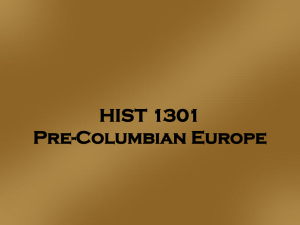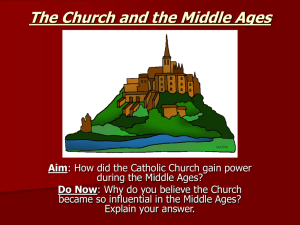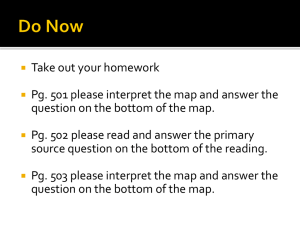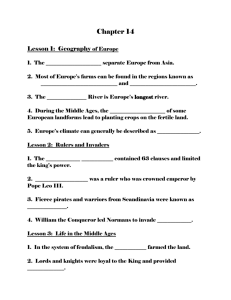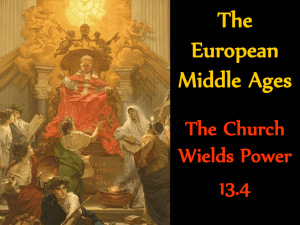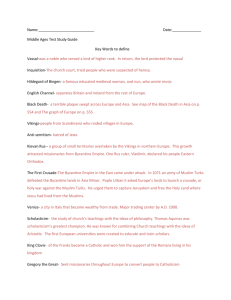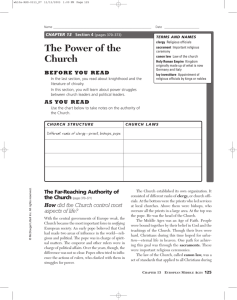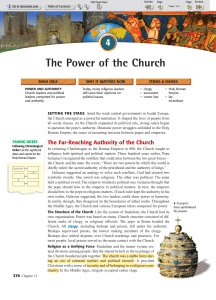Chapter 13.4- The Church Wields Power I. The Scope of Church Authority
advertisement
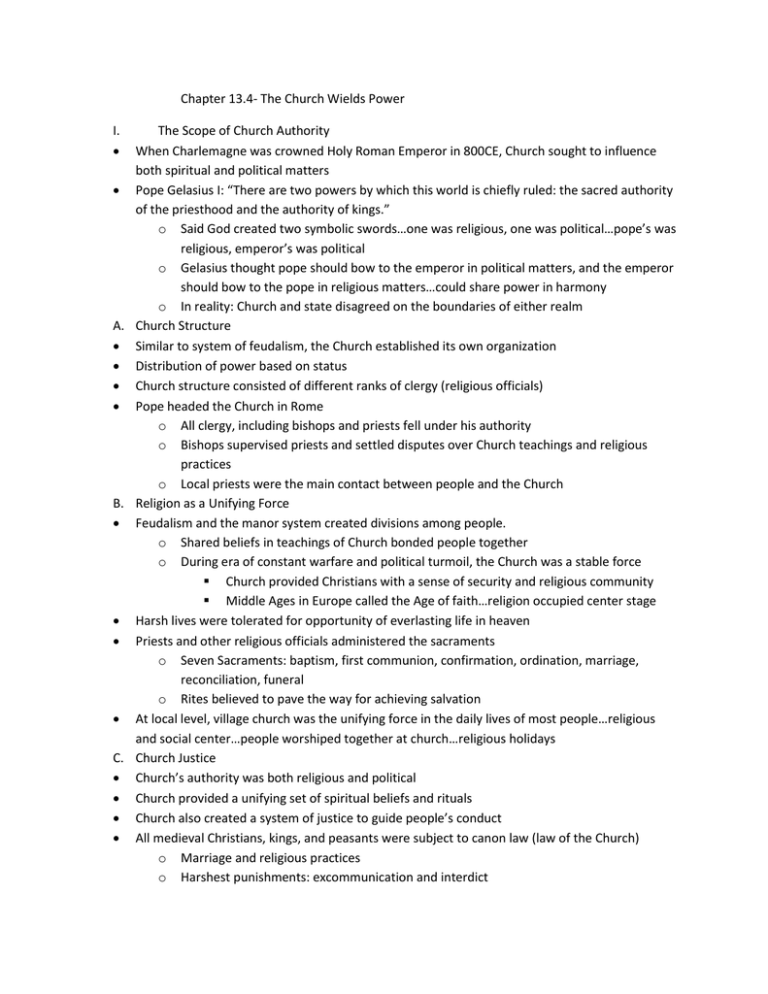
Chapter 13.4- The Church Wields Power I. The Scope of Church Authority When Charlemagne was crowned Holy Roman Emperor in 800CE, Church sought to influence both spiritual and political matters Pope Gelasius I: “There are two powers by which this world is chiefly ruled: the sacred authority of the priesthood and the authority of kings.” o Said God created two symbolic swords…one was religious, one was political…pope’s was religious, emperor’s was political o Gelasius thought pope should bow to the emperor in political matters, and the emperor should bow to the pope in religious matters…could share power in harmony o In reality: Church and state disagreed on the boundaries of either realm A. Church Structure Similar to system of feudalism, the Church established its own organization Distribution of power based on status Church structure consisted of different ranks of clergy (religious officials) Pope headed the Church in Rome o All clergy, including bishops and priests fell under his authority o Bishops supervised priests and settled disputes over Church teachings and religious practices o Local priests were the main contact between people and the Church B. Religion as a Unifying Force Feudalism and the manor system created divisions among people. o Shared beliefs in teachings of Church bonded people together o During era of constant warfare and political turmoil, the Church was a stable force Church provided Christians with a sense of security and religious community Middle Ages in Europe called the Age of faith…religion occupied center stage Harsh lives were tolerated for opportunity of everlasting life in heaven Priests and other religious officials administered the sacraments o Seven Sacraments: baptism, first communion, confirmation, ordination, marriage, reconciliation, funeral o Rites believed to pave the way for achieving salvation At local level, village church was the unifying force in the daily lives of most people…religious and social center…people worshiped together at church…religious holidays C. Church Justice Church’s authority was both religious and political Church provided a unifying set of spiritual beliefs and rituals Church also created a system of justice to guide people’s conduct All medieval Christians, kings, and peasants were subject to canon law (law of the Church) o Marriage and religious practices o Harshest punishments: excommunication and interdict II. A. B. III. A. B. Excommunication: banishment from the church…not allowed to take part in sacraments, therefore, believed you were denying them salvation o Also freed all the king’s vassals from their duties to him Interdict: sacraments and religious services could not be performed in the king’s lands…essentially saying that the entire kingdom would not gain salvation The Church and the Holy Roman Empire After the death of Charlemagne, the Holy Roman Empire was the strongest kingdom that arose from the ruins of his empire. Otto I Allies with the Church Most effective ruler of medieval Germany Otto the Great Crowned king in 936, copied the policies of Charlemagne Otto formed a close alliance with the Church Tried to limit the nobles strength with help from the clergy Built up his power base by gaining support of bishops and abbots (heads of monasteries) Otto dominated the Church in Germany…used his power to defeat unruly German princes Otto also invaded Italy on the pope’s behalf and in 962, he was crowned emperor by the pope Signs of Future Conflicts Otto’s German-Italian empire was first called the Roman Empire of the German Nation…later called the Holy Roman Empire Holy Roman Empire was the strongest state in Europe until about 1100 However, Italian nobles resented German rule, and popes also came to fear the political power that German emperors held over Italy Holy Roman Emperor Clashes with the Pope Church began to resent the control that kings, like Otto, exercised over clergy and their offices Lay Investiture- ceremony in which kings and nobles appoint church officials…idea was that if you gave the appointment, the designee was beholden to you Church reformers felt that bishops should not be under the power of any king 1075 Pope Gregory VII banned lay investiture German Emperor, Henry IV, sent a vicious letter to Gregory VII calling Gregory a “false monk” and demanding that he step down from the papacy. Gregory VII excommunicated Henry…German bishops and princes sided with the pope…Henry decided he needed to ask for forgiveness (worried about an interdict) Showdown at Canossa January 1077, Henry IV went through the Alps to the Italian town of Canossa where Pope Gregory was vacationing…Gregory made Henry wait in the snow for 3 days before ending his excommunication Henry then went home and punished the nobles who had rebelled against him Key question of lay investiture still undecided Concordat of Worms Debate continued until 1122…when representatives of the Church and the emperor met in the German city of Worms and reached a compromise known as the Concordat of Worms… o Church alone could grant a bishop his ring and staff, symbols of Church office o Emperor had the power to veto to prevent the appointment of a particular bishop Struggle between church and state authority continued IV. Renewed Church Conflicts Under Frederick I 1152- German princes elected Frederick I- “Barbarossa- red beard” because they felt he would be a strong leader Frederick I was the first ruler to call his lands the Holy Roman Empire o Forceful personality and military skills enabled him to dominate Frederick I repeatedly invaded the rich cities of Italy o His brutal tactics spurred Italian merchants to unite against him o Frederick also angered the pope, who joined the merchants o Frederick’s enemies formed the Lombard League 1176- foot soldiers of Lombard League faced Frederick’s army of mounted knights at the Battle of Legnano o Foot soldiers used crossbows to defeat the feudal knights for the first time in history 1177- Frederick made peace with the pope and returned to Germany…but his defeat undermined his authority with the German princes 1190- Frederick Barbarossa drowned and his empire dissolved into an array of fragmented feudal states. V. German States Remain Separate German kings continued to get involved in Italian politics and tried to revive Charlemagne’s empire and alliance with the Church Led to wars with Italian cities and to further clashes with the pope Feudal states of Germany did not unify during the Middle Ages System of German princes electing the king weakened royal authority o German rulers controlled fewer royal lands to use a base of power than French and English kings, who were establishing strong central authority Feudalism in France and England, spurred the rise of powerful leaders Name: ____________________ Date: ____________ Period: __ Chapter 13.4 Reading Quiz 1. Who was Otto I ? (Time Period, Location, and Key Achievements) 10th century AD…crowned king in 936…modern day Germany…invaded Italy…crowned Holy Roman Emperor…allied with the Catholic Church in order to gain power. 2. What were the causes, key events, and outcome of the lay investiture debate? Causes: Lay investiture is when a person outside of the church hierarchy (lay person) appoints people within the church hierarchy (ex: bishops)…kings wanted to practice lay investiture so that leaders in the church would be beholden to the state. Pope Gregory VII- banned the practice of lay investiture…Emperor Henry IV protested and wrote a scathing letter to Gregory…Pope excommunicated Henry…not resolved until next generation… Effects: Concordat of Worms…church hierarchy would appoint leaders within the hierarchy, but lay people could give titles to those appointed people…compromise, but indicative of conflicts to come between church and state 3. Who was Frederick I ? (Time Period, Location, and Key Achievements) 1152- elected emperor by German princes…first to call his lands the Holy Roman Empire…repeatedly invaded Italy…angered the pope…defeated at the Battle of Legnano…drowned in 1190
